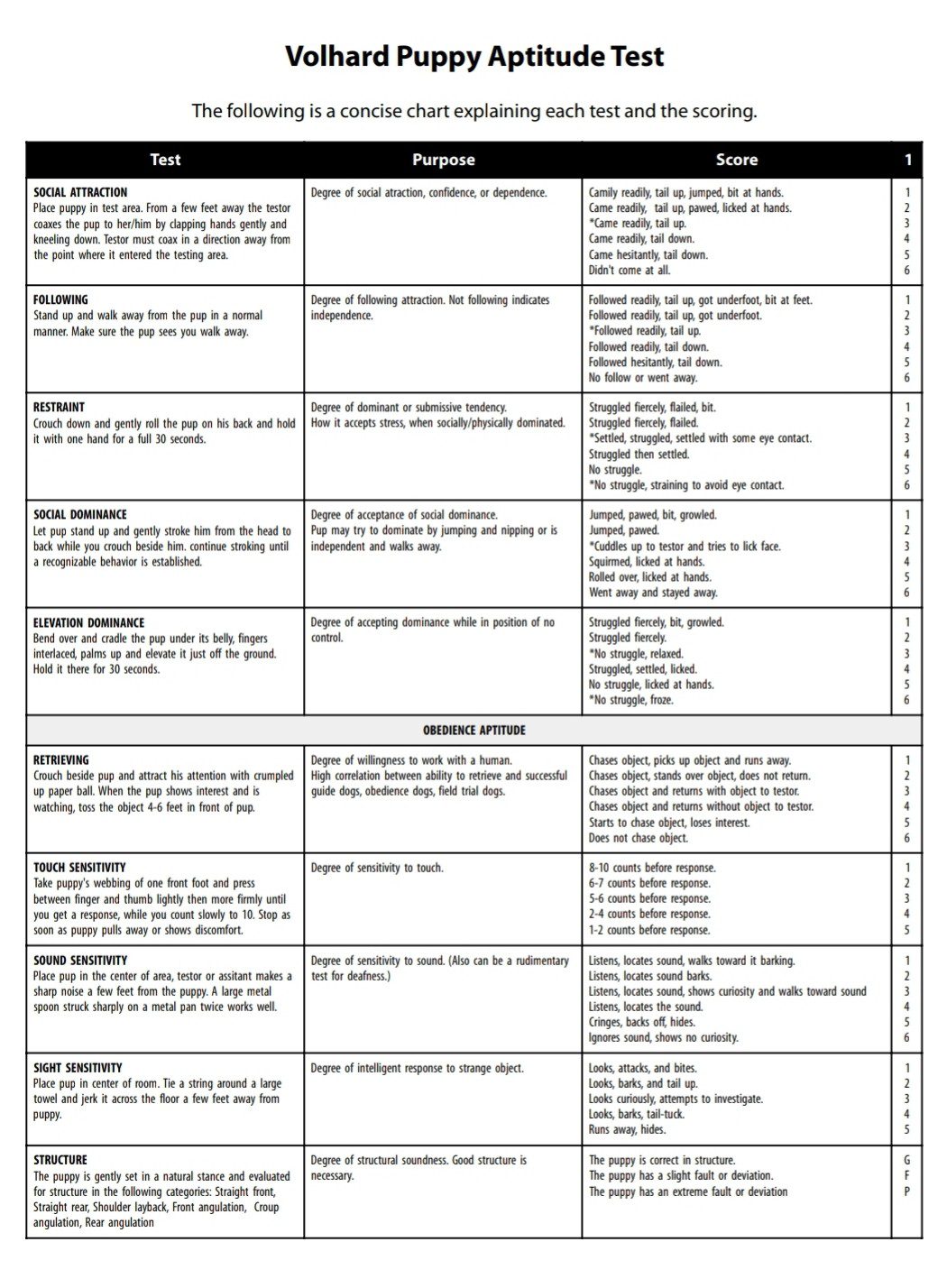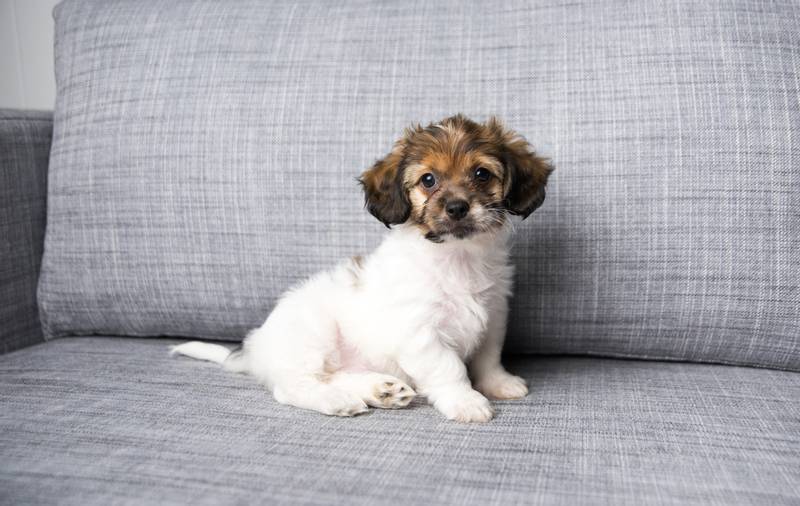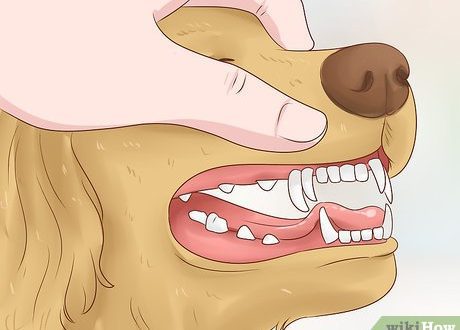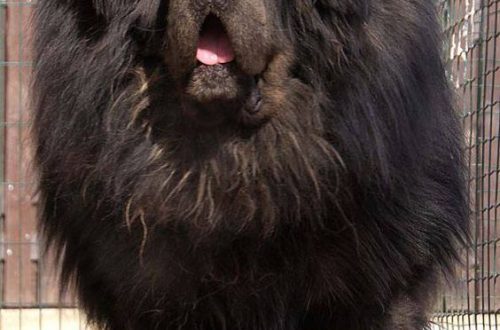
What is the Fisher-Volhard test?
What is the importance of this procedure? They often say: which puppy will suit you at the meeting – take that one. And they take it. And they also take “That bigger one over there” or regret it – “That thin one over there.” Or visually – “That white one over there.”
All these preferences, of course, have the right to be. Love at first sight has not been canceled. But it will be very correct if it is backed up “according to science.” It is possible that, based on the results of the test, you decide to take another baby.

An animal is tested at the age of 45-50 days, just when the time comes for the puppies to go to new owners.
The Fisher-Volhard test does not require special preparation. Just ask the breeder to take the puppy you like to a separate room, and not by the scruff, but neatly in your arms. In order not to frighten the baby in advance. When testing, the breeder should neither address the baby nor express his emotions. The characters are you and the dog.
The animal must be placed in the center of the free space, you are four steps away from it. In total, you and your puppy will have to go through ten different tests. Evaluation – on a six-point scale.
Contents
So, the test itself:
Commitment to the society of man
It is necessary to squat down and call the puppy, clap your hands, smack, whistle:
1 – the puppy is actively interested, runs up, wagging its tail, jumps, bites on outstretched hands;
2 – confidently approaches, wagging his tail, asks for hands;
3 – fits, wagging its tail;
4 – fits, the tail is tucked in;
5 – fits uncertainly, the tail is tucked in;
6 is not suitable at all.
Desire to follow a person
You need to slowly get up and pretend that you are leaving, while calling the puppy to follow you:
1 – runs confidently at the very feet, tail like a carrot, wants to grab the legs;
2 – confidently runs after you, tail up;
3 – confidently runs after you, but at a short distance, tail up;
4 – runs after you, the tail is lowered;
5 – walking reluctantly, tail tucked in;
6 – refuses to go.
Retention
A very important test showing a tendency towards dominance. Gently turn the baby on its back and hold it with your palm for 30 seconds:
1 – immediately starts to break out, tries to bite;
2 – actively breaks out;
3 – breaks out, tries to catch your eye;
4 – breaks out, but then calms down;
5 – does not try to escape;
6 – does not try to escape, but avoids making eye contact with you.
You need to sit on the floor next to the puppy, and so that he can lick you if he wants. Lightly pat him on the pope and back:
1 – jumps, beats with paws, bites;
2 – jumps up, beats with paws;
3 – caresses and tries to lick in the face;
4 – licks hands;
5 – lies on the back and licks hands;
6 – leaves.
Climb dominance
It is necessary to raise the puppy, with its muzzle towards you, and hold it for about 30 seconds:
1 – breaks out with all his might, tries to bite;
2 – actively breaks out;
3 – hangs quietly;
4 – breaks out, tries to lick;
5 – does not break out, licks hands;
6 – freezes.
Interest in playing with a person
It is necessary to sit on the floor, put the puppy next to him and wave a toy in front of his face, and even a crumpled piece of paper. Then throw this item a couple of steps forward:
1 – runs to the toy, grabs it and takes it away;
2 – runs to the toy, grabs it and fiddles;
3 – runs to the toy, grabs it and brings it to you;
4 – runs to the toy, but does not bring;
5 – begins to move towards the toy, but loses interest in it;
6 – not interested in the toy.
Reaction to pain
It is necessary to gently squeeze the puppy’s paw. Gradually increase the compression strength, counting to ten. Let go as soon as the dog becomes uncomfortable:
1 — reaction at account 8–10;
2 — reaction at account 6–8;
3 — reaction at account 5–6;
4 — reaction at account 3–5;
5 — reaction at account 2–3;
6 — reaction to account 1–2.
Reaction to sound
Hit the bowl or saucepan behind the puppy with a spoon and watch his reaction:
1 – barks and runs to understand the situation;
2 – hears a sound and barks;
3 – is interested and goes to see what is there, but does not bark;
4 – turns around to the noise;
5 – scared;
6 – not interested.
visual reaction
You need to tie a rope to some rag or handkerchief and tease the puppy:
1 – attacks and bites;
2 – looks, barks and wags its tail;
3 – trying to catch up;
4 – looks and barks, the tail is tucked up;
5 – scared;
6 – not interested.
Reaction to an unfamiliar object
It is necessary, without making sudden movements, to open the umbrella and put it near the puppy:
1 – runs to the umbrella, sniffs, tries to bite;
2 – runs to the umbrella, sniffs;
3 – carefully approaches the umbrella, sniffs;
4 – looks, does not fit;
5 – runs away;
6 – not interested.


During testing, you should write down your observations of the puppy.
The puppy with the most 1s will be the dominant, aggressive and active dog. It is difficult for beginners to cope with such a dog, especially if it is a serious breed. An experienced person will be able to raise an excellent guard, hunter, bodyguard.
Twos predominate – the “light version” of number 1.
Threes – the dog will be active with a slight tendency to dominate. Excellent prospects to raise a working or show pet.
Fours – a dog for a family with children or for people leading a calm lifestyle, a companion dog.
Fives are a timid and modest animal that will have to be patronized a little, but it will coexist well with other animals in the same territory.
Sixes are a tricky case. An independent and independent canine personality who has little interest in you. These are found mainly among northern and hunting breeds. You will have to make a lot of efforts to somewhat correct the situation.
Of course, with all the reliability of the results, there are exceptions. For example, a puppy is in pain. Or he is the breeder’s favorite, and no longer wants to recognize anyone else. So tests are tests, and when choosing a pet, listen to your heart too. “That little white one over there” – perhaps this is just your friend for many years.





